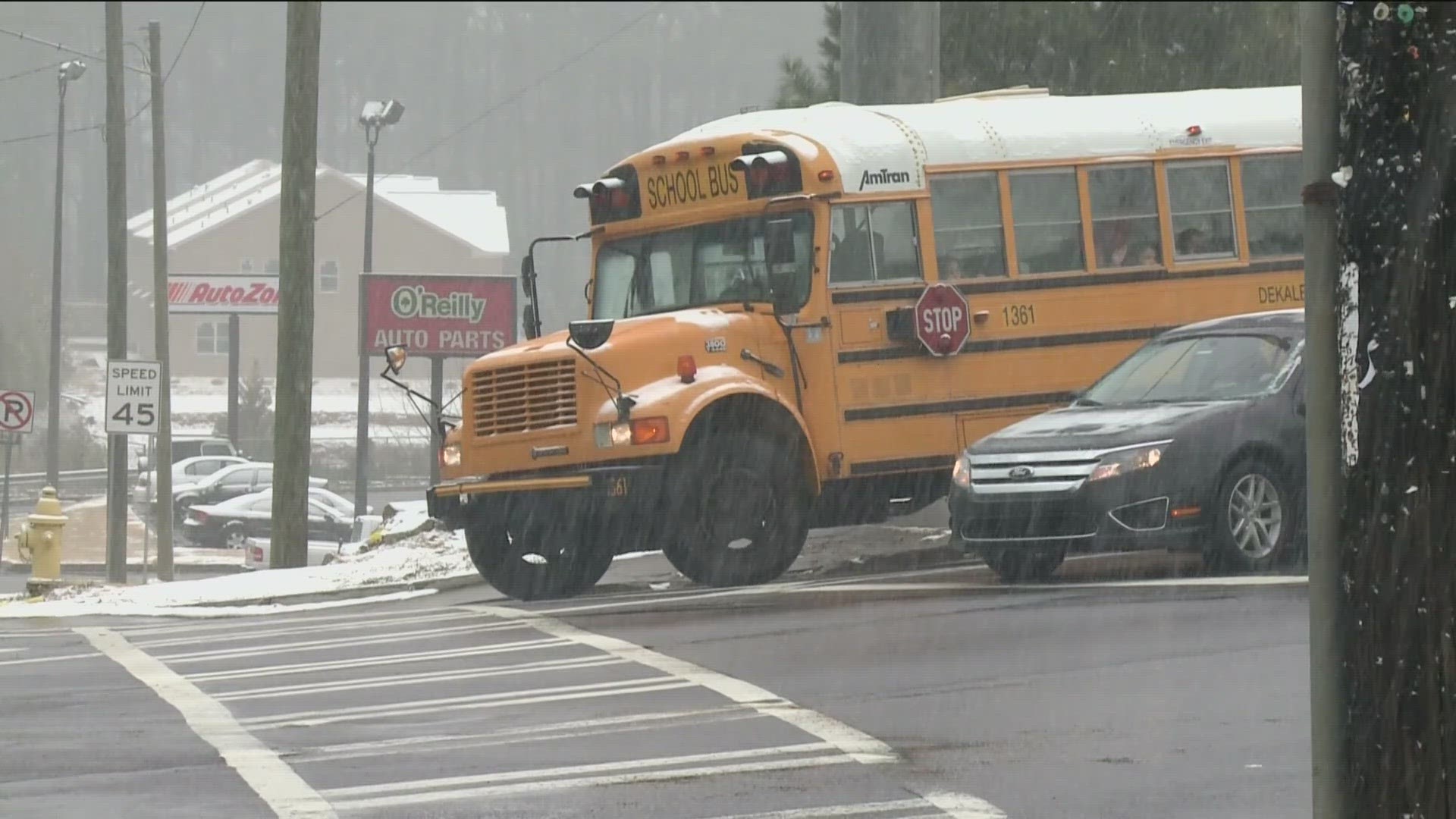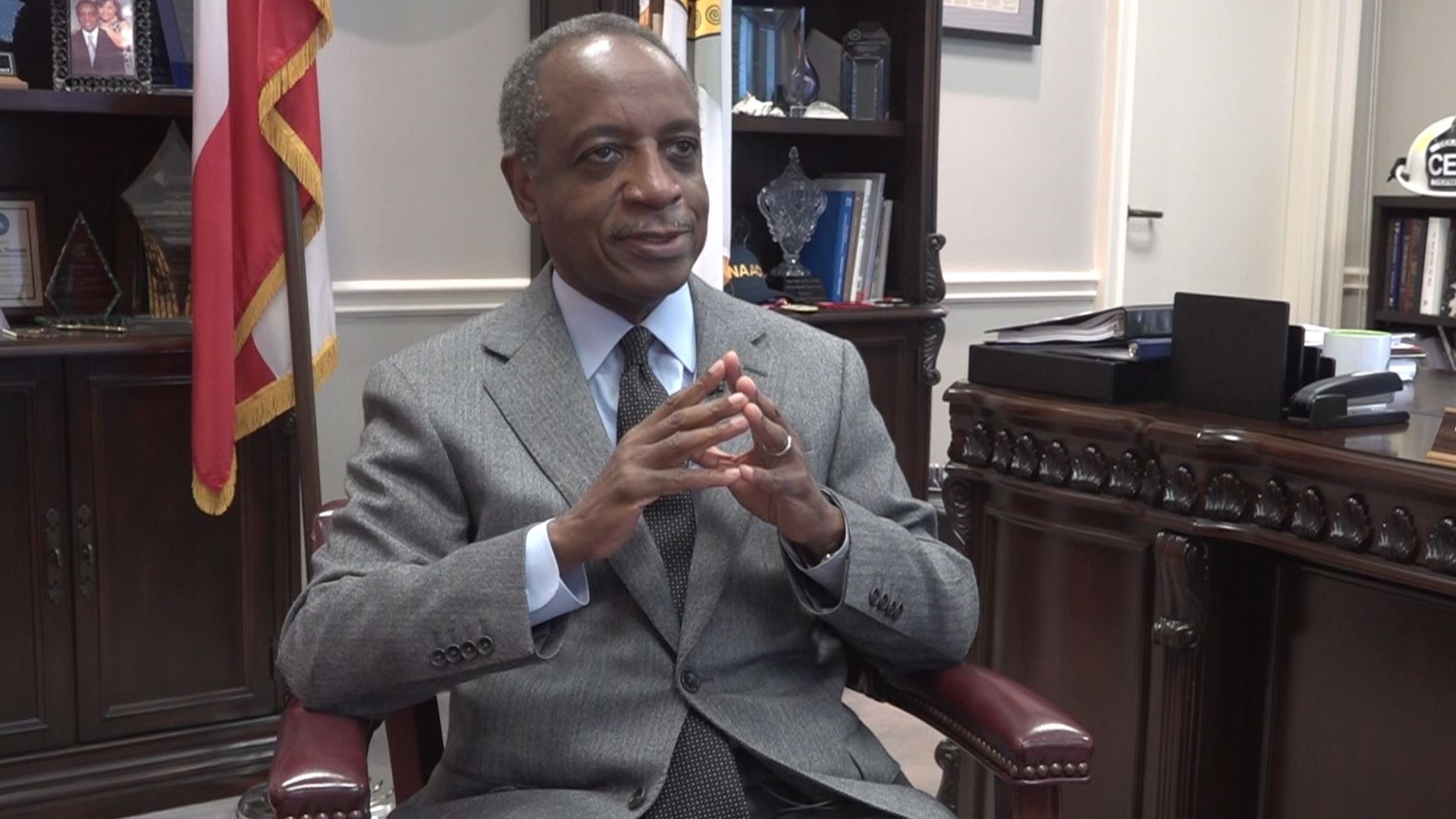ATLANTA — One of the most stressful parts of the 2014 winter storm termed “Snow Jam” was reconnecting families.
School buses full of kids were stuck on the roads, hundreds of students had to shelter at their schools overnight, and panicked parents were also stuck on the roads trying to reach their children or figure out where they were.
Since 2014, school officials across the metro learned to be hyper-aware of the weather.
That one event changed everything about the way districts make decisions present day about whether to stay open or close.
Chuck Gardner, the Chief Operations Officer for Marietta City Schools, was one of the thousands stuck for hours on the interstate when schools closed early that January day in 2014.
“I’m sitting on the interstate, but at least I’m not locked in a gym with 1,400 kids trying to figure out how to feed them,” he said.
The sight of school buses full of kids trapped in the cold for 16 hours filled parents with dread.
11Alive crews spoke to a student who was stuck on a bus during that time.
“We had to go a long time with no food. People had to use the restroom. It was horrible,” she said.
DeKalb County CEO Michael Thurmond was the Superintendent of the DeKalb County School District at the time.
“A veteran educator said the most difficult decision you will make during your superintendency is when to close schools during inclement weather,” Thurmond said.
He said that turned out to be true.
Unlike almost every other metro district, DeKalb County Schools had to shelter only six children who couldn’t make it home because they made one critical decision to keep bus drivers on the clock and pre-position the buses for their afternoon pickups. So, when it started to snow, they were ready to roll.
Full interview with Michael Thurmond
“I remember there was a debate. Can we afford to spend $40,000 to keep people on the clock? And the answer was yes. That was the best $40,000 I ever spent,” Thurmond said.
Pre-positioning buses turned out to be a tactic they follow to this day. They named it “The Fretwell Rule,” named after Dr. Quentin Fretwell, who still works for the district as the dedicated weather information gatherer.
While the Superintendent makes the ultimate decision on whether to close the school, people like Dr. Fretwell gather the information for the decision.
Over the decades, he has developed a specific way of handling weather events.
“I stay up all night. I think I am a closet meteorologist,” Dr. Fretwell said. “The things we do for children, we have to take it seriously.”
Haunted by the images of 2014, school districts are determined never to repeat that day.
“When you’re thinking about putting somebody who’s potentially five years old on a school bus, you can’t mess that up,” Gardner said.
After 2014, districts across the metro made changes, many coming out of Gov. Nathan Deal’s appointed Severe Weather Warning Task Force.
It gathered experts across industries, including meteorologists, utility companies, school districts, and elected officials, to discuss necessary improvements to winter weather response. The task force released a report of recommendations six weeks later.
One of the biggest changes for school districts was improved communication.
“We engage earlier with the National Weather Service. We engage earlier with local emergency management associations. There’s a lot of collaboration now between local school districts. Like, all of the Chief Operating Officers and Superintendents are constantly talking . . . so we’re kind of all on the same page. And, you’ve got a lot more data at your fingertips,” Gardner said.
School districts now have access to the National Weather Service chat. They’re not allowed to write or contribute, but they can read the constant updates on changing weather.
“We’re getting real-time information at the same time the meteorologists are getting it,” Gardner said.
Districts also have access to the state’s network of road sensors. Leaders say that tool has been critical in deciding whether road conditions are safe enough for buses, parents, and staff to travel.
If it seems like schools are more willing to close now than they were before, it’s because they are.
“I notice even now there’s greater sensitivity and less willingness to take chances,” Thurmond said.
Gardner agreed, saying, “Now we pay attention to every single one of the [National Weather Service] briefings, knowing that the weather is very unpredictable, and it could change at any given time.”
Districts are fully aware of the hardship that comes with closing schools. Leaders emphasize it’s a decision they take seriously.
“Not only do you impact 100,000 students, but tens of thousands of parents, employers, food service preparation. Everything you can imagine is impacted by that decision," Thurmond explained.
Schools must make a decision whether to close by 5:30 a.m. A decision any later than that causes chaos, even without the snow.
“It’s a hardship on families, so we don’t like to cancel school. When we do make that decision, we try to do it as early as possible because canceling school at 5:00 in the afternoon for the next day might be inconvenient, but it’s not nearly as inconvenient as canceling at 5:00 a.m. the next morning,” Gardner said. “There is a lot of pressure, and you’ll get beat up by somebody regardless of what decision you make. All you can do is make the best decision with the best information that you have at the time.”
Districts say virtual learning can help some days, but educators cannot assume every home has access to a device and the internet on short notice, so they always prefer learning to happen in the classroom.
Ultimately, the decision comes down to safety.
“For metro Atlanta, it really was a defining moment. This state has changed forever in terms of how we respond to weather-related crises,” Thurmond said.
Full responses from agencies on how winter preparations have changed since 2014
Atlanta Mayor's Office
The Mayor’s Office of Emergency Preparedness was created to ensure the City of Atlanta has precautionary measures in place for potential disasters and to work with federal and state Emergency Management Agency partners and community stakeholders.
Now, MOEP also leads cross-organizational coordination of preparedness and response planning, supports cross-organizational responses to emergencies and large planned events, and develops Citywide preparedness plans and coordinates interdepartmental and cross-functional responses. Additionally, MOEP conducts several Citywide exercises to ensure the City of Atlanta is prepared for Winter Weather (and other significant events).
In 2019, Atlanta Department of Transportation (ATLDOT) was created to serve as the coordinating agency for all transportation matters within the City, leading right-of-way pre-treatment (anti-icing), de-icing, and plowing during winter weather events. Like MOEP which conducts Citywide exercises, ATLDOT conducts more focused exercises for the Department and support departments. Additionally, ATLDOT now stockpiles over 6,000 tons of salt and 23,500 gallons of brine. ATLDOT can also make their own brine. As a result of the outstanding planning and preparedness, ATLDOT was the recipient of the 2023 APWA Excellence in Snow and Ice Control Award.
Some of the major wins as a result:
Significantly improved coordination amongst and between City of Atlanta departments, offices, and agencies.
Improved horizontal and vertical communication and coordination through multi-layer planning process and improved decision-making as a result of better communication.
Planning inclusive of ALL departments, offices, agencies – and YEAR ROUND
We’ve progressed not just in preparedness, but in how we prepare and respond to winter weather events. Back in 2014 – sand/gravel mixture; After 2014
COA instituted using brine (liquid)
Worked with NWS to develop specific temperature/weather-specific plans – WEATHER CONDITIONS DICTATE APPROACH – more proactive in our approach, too
Have the ability to produce our own brine
added a seasonal rental program to meet potential needs
Enhanced partnerships:
Georgia Emergency Management Agency
National Weather Service (better relationship than ever before – frequent communication)
Increased communication with APS – share plans, discuss plans
GEMA
GEMA/HS restructured how we respond to winter weather events following that 2014 event. By hiring a State Meteorologist, Will Lanxton, we have been able to understand and communicate the forecasted impacts of future weather events and can better prepare for and respond to weather events prior to, and as they occur more thoroughly.
Will Lanxton’s role has remained the same during his tenure. He is a valuable member of the team, and his work is critical to the decision-making process with weather events.
We have briefings starting several days out when freezing precipitation is forecast anywhere near Metro Atlanta as well as the rest of the State. The Director is closely tied into the Governor and staff on all decisions related to weather and there is continual communication to allow for immediate action if necessary.
We also rewrote the Winter Weather Incident Annex to include a Synchronization Matrix based on the anticipated time until the forecasted weather impacts Georgia, thus enabling all supporting state agencies to best prepare for the anticipated weather emergencies.
Additionally, we worked to increase our reach to the public through multiple social media platforms, including Facebook, Instagram, X and Next Door to provide timely information regarding expected impacts and steps citizens can take to prepare.
The Georgia Department of Transportation (GDOT) leads our Emergency Support Function-1 (Transportation) and has invested heavily in their brining and road clearing infrastructure throughout the northern half of the state. When the National Weather Service’s weather forecast predicts wintery precipitation, GDOT takes preparatory actions well in advance to treat state highways/interstate highways to lessen the likelihood of significant traffic issues. GDOT personnel are detailed from throughout the state to locations predicted to receive frozen precipitation to increase manpower to accomplish their preparatory treatments prior to the onset of inclement weather. These preparatory treatments are also supported by Emergency Support Function-13 (Law Enforcement) and Emergency Support Function-16 (Defense).
Fulton County Schools
After the events of the winter storm of 2014, the district's Emergency Response Team reviewed their processes and created new mechanisms for review and notification. Examples include upgrading our parent mass notification system from a single modality to multiple methods: robocalls, email, SMS/text messaging which is then pushed to the FCS app, and clear messaging on our website and social media channels.
More information on the current factors in the process can be found here: https://www.fultonschools.org/weather.
Georgia School Superintendents Association
(Questions from 11Alive, responses from Executive Director John Zauner)
Does this policy of emailing all superintendents about impending severe weather still exist? Not with inclement weather conditions. We worked with Gov.’s office and GEMA on this issue back in 2014.
Do state officials still work with GSSA to keep the email list of school superintendents current? We do offer an updated superintendent email list upon request from Gov.’s office for communication purposes.
When was the most recent time this policy was used? Was it used during severe weather the week of Jan 8, 2024? We no longer provide a regular communication on weather related issues since there are many other forms of contacting local districts through their local GEMA offices that now exist. The communication has much improved and has been streamlined from Gov.’s and GEMA offices to local school districts.


